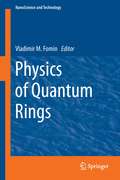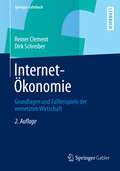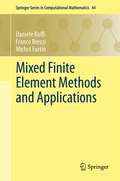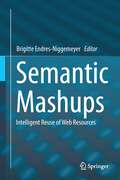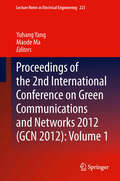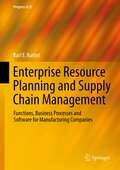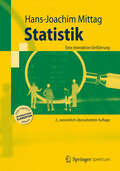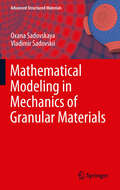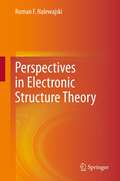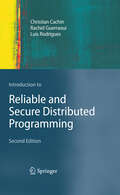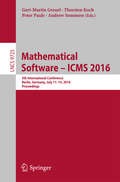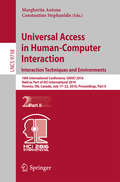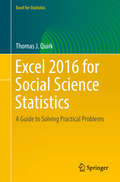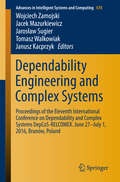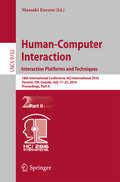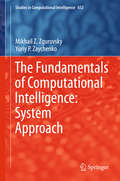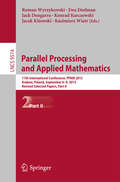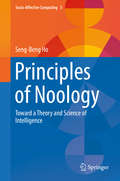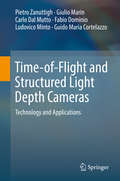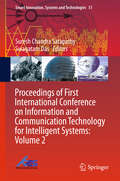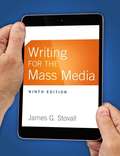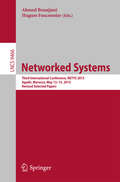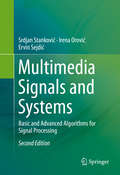- Table View
- List View
Physics of Quantum Rings
by Vladimir FominThis book deals with a new class of materials, quantum rings. Innovative recent advances in experimental and theoretical physics of quantum rings are based on the most advanced state-of-the-art fabrication and characterization techniques as well as theoretical methods. The experimental efforts allow to obtain a new class of semiconductor quantum rings formed by capping self-organized quantum dots grown by molecular beam epitaxy. Novel optical and magnetic properties of quantum rings are associated with non-trivial topologies at the nanoscale. An adequate characterization of quantum rings is possible on the basis of modern characterization methods of nanostructures, such as Scanning Tunneling Microscopy. A high level of complexity is demonstrated to be needed for a dedicated theoretical model to adequately represent the specific features of quantum rings. The findings presented in this book contribute to develop low-cost high-performance electronic, spintronic, optoelectronic and information processing devices based on quantum rings.
Internet-Ökonomie: Grundlagen und Fallbeispiele der vernetzten Wirtschaft
by Dirk Schreiber Reiner ClementInnovative Informations- und Kommunikationstechniken bzw. -technologien, das Internet und der Mobilfunk sind inzwischen fester und unverrückbarer Bestandteil unseres Alltags. Der noch vor Jahrzehnten beschriebene Strukturwandel zur Wissensgesellschaft ist Wirklichkeit. Das Web 2.0 verändert die Grundformen der ökonomischen Leistungserstellung und macht neue Arten der Interaktion zwischen Unternehmen und Kunden sowie der Nutzer untereinander möglich. Das Buch untersucht die Prinzipien der Internet-Ökonomie und die Auswirkungen des Internets für Grundformen der ökonomischen Leistungserstellung. Dazu zählen das Kaufen und Verkaufen auf elektronischen Märkten, das Tauschen, Teilen und die soziale Interaktion in sozialen Netzwerken. Das Buch entwickelt dazu einen systematischen und übergreifenden Ansatz. Eine Vielzahl von Fallbeispielen und Übungsaufgaben bieten einen hohen Anwendungsbezug. Die Lösungshinweise zu den Fallbeispielen und Übungsaufgaben sowie rund 300 Abb. sind als Download unter http://www.springer.com verfügbar.
Mixed Finite Element Methods and Applications
by Franco Brezzi Daniele Boffi Michel FortinNon-standard finite element methods, in particular mixed methods, are central to many applications. In this text the authors, Boffi, Brezzi and Fortin present a general framework, starting with a finite dimensional presentation, then moving on to formulation in Hilbert spaces and finally considering approximations, including stabilized methods and eigenvalue problems. This book also provides an introduction to standard finite element approximations, followed by the construction of elements for the approximation of mixed formulations in H(div) and H(curl). The general theory is applied to some classical examples: Dirichlet's problem, Stokes' problem, plate problems, elasticity and electromagnetism.
Semantic Mashups
by Brigitte Endres-NiggemeyerMashups are mostly lightweight Web applications that offer new functionalities by combining, aggregating and transforming resources and services available on the Web. Popular examples include a map in their main offer, for instance for real estate, hotel recommendations, or navigation tools. Mashups may contain and mix client-side and server-side activity. Obviously, understanding the incoming resources (services, statistical figures, text, videos, etc.) is a precondition for optimally combining them, so that there is always some undercover semantics being used. By using semantic annotations, neutral mashups permute into the branded type of semantic mashups. Further and deeper semantic processing such as reasoning is the next step. The chapters of this book reflect the diversity of real-life semantic mashups. Two overview chapters take the reader to the environments where mashups are at home and review the regulations (standards, guidelines etc.) mashups are based on and confronted with. Chapters focusing on DBpedia, search engines and the Web of Things inspect the main Web surroundings of mashups. While mashups upgrading search queries may be nearer to the everyday experience of readers, mashups using DBpedia input and sensor data from the real world lead to important new and therefore less known developments. Finally, the diversity of mashups is tracked through a few application areas: mathematical knowledge, speech, crisis and disaster management, recommendations (for games), inner-city information, and tourism. Participants of the AI Mashup Challenge wrote all the chapters of this book. The authors were writing for their current and future colleagues - researchers and developers all over the Web who integrate mashup functionalities into their thinking and possibly into their applications.
Proceedings of the 2nd International Conference on Green Communications and Networks 2012: Volume 3 (GCN #2012)
by Maode Ma Yuhang YangThe objective of the 2nd International Conference on Green Communications and Networks 2012 (GCN 2012) is to facilitate an exchange of information on best practices for the latest research advances in the area of communications, networks and intelligence applications. These mainly involve computer science and engineering, informatics, communications and control, electrical engineering, information computing, and business intelligence and management. Proceedings of the 2nd International Conference on Green Communications and Networks 2012 (GCN 2012) will focus on green information technology and applications, which will provide in-depth insights for engineers and scientists in academia, industry, and government. The book addresses the most innovative research developments including technical challenges, social and economic issues, and presents and discusses the authors' ideas, experiences, findings, and current projects on all aspects of advanced green information technology and applications. Yuhang Yang is a professor at the Department of Electronic Engineering, Shanghai Jiao Tong University. Maode Ma is an associate professor at the School of Electrical & Electronic Engineering, Nanyang Technological University.
Enterprise Resource Planning and Supply Chain Management: Functions, Business Processes and Software for Manufacturing Companies
by Karl Eugen KurbelThis book is about running modern industrial enterprises with the help of information systems. Enterprise resource planning (ERP) is the core of business information processing. An ERP system is the backbone of most companies' information systems landscape. All major business processes are handled with the help of this system. Supply chain management (SCM) looks beyond the individual company, taking into account that enterprises are increasingly concentrating on their core competencies, leaving other activities to suppliers. With the growing dependency on the partners, effective supply chains have become as important for a company's success as efficient in-house processes. This book covers typical business processes and shows how these processes are implemented. Examples are presented using the leading systems on the market - SAP ERP and SAP SCM. In this way, the reader can understand how business processes are actually carried out "in the real world".
Statistik
by Hans-Joachim MittagBeim Multimedia-Comenius-Wettbewerb 2011 ausgezeichnet, bietet das Lehrbuch als Kombination aus Druckwerk und interaktiver Online-Fassung eine gelungene Einführung in die Statistik. Das Anwendungsspektrum der Statistik wird anhand aktueller Beispiele illustriert, die statistischen Konzepte in Grafiken visualisiert. Der Band enthält viele Übungsaufgaben mit ausführlichen Lösungen. Die überarbeitete 2. Auflage wird durch neue interaktive Experimente und tongestützte Animationen ergänzt und bietet frei zugängliche Multimedia-Ressourcen im Internet.
Mathematical Modeling in Mechanics of Granular Materials
by Holm Altenbach Oxana Sadovskaya Vladimir SadovskiiThis monograph contains original results in the field of mathematical and numerical modeling of mechanical behavior of granular materials and materials with different strengths. It proposes new models helping to define zones of the strain localization. The book shows how to analyze processes of the propagation of elastic and elastic-plastic waves in loosened materials, and constructs models of mixed type, describing the flow of granular materials in the presence of quasi-static deformation zones. In a last part, the book studies a numerical realization of the models on multiprocessor computer systems. The book is intended for scientific researchers, lecturers of universities, post-graduates and senior students, who specialize in the field of the deformable materials mechanics, mathematical modeling and adjacent fields of applied and calculus mathematics.
Perspectives in Electronic Structure Theory
by Roman F. NalewajskiThe understanding in science implies insights from several different points of view. Alternative modern outlooks on electronic structure of atoms and molecules, all rooted in quantum mechanics, are presented in a single text. Together these complementary perspectives provide a deeper understanding of the localization of electrons and bonds, the origins of chemical interaction and reactivity behavior, the interaction between the geometric and electronic structure of molecules, etc. In the opening two parts the basic principles and techniques of the contemporary computational and conceptual quantum chemistry are presented, within both the wave-function and electron-density theories. This background material is followed by a discussion of chemical concepts, including stages of the bond-formation processes, chemical valence and bond-multiplicity indices, the hardness/softness descriptors of molecules and reactants, and general chemical reactivity/stability principles. The insights from Information Theory, the basic elements of which are briefly introduced, including the entropic origins and Orbital Communication Theory of the chemical bond, are the subject of Part IV. The importance of the non-additive (interference) information tools in exploring patterns of chemical bonds and their covalent and ionic components will be emphasized.
Introduction to Reliable and Secure Distributed Programming
by Christian Cachin Luís Rodrigues Rachid GuerraouiThe scope of this second edition of the introduction to fundamental distributed programming abstractions has been extended to cover 'Byzantine fault tolerance'. It includes algorithms to implement these abstractions in vulnerable distributed systems.
Mathematical Software - ICMS 2016
by Peter Paule Gert-Martin Greuel Thorsten Koch Andrew SommeseThis book constitutes the proceedings of the 5th International Conference on Mathematical Software, ICMS 2015, held in Berlin, Germany, in July 2016. The 68 papers included in this volume were carefully reviewed and selected from numerous submissions. The papers are organized in topical sections named: univalent foundations and proof assistants; software for mathematical reasoning and applications; algebraic and toric geometry; algebraic geometry in applications; software of polynomial systems; software for numerically solving polynomial systems; high-precision arithmetic, effective analysis, and special functions; mathematical optimization; interactive operation to scientific artwork and mathematical reasoning; information services for mathematics: software, services, models, and data; semDML: towards a semantic layer of a world digital mathematical library; miscellanea.
Universal Access in Human-Computer Interaction. Interaction Techniques and Environments
by Margherita Antona Constantine StephanidisThe three-volume set LNCS 9737-9739 constitutes the refereed proceedings of the 10th International Conference on Universal Access in Human-Computer Interaction, UAHCI 2016, held as part of the 10th International Conference on Human-Computer Interaction, HCII 2016, in Toronto, ON, Canada in July 2016, jointly with 15 other thematically similar conferences. The total of 1287 papers presented at the HCII 2016 conferences were carefully reviewed and selected from 4354 submissions. The papers included in the three UAHCI 2016 volumes address the following major topics: novel approaches to accessibility; design for all and eInclusion best practices; universal access in architecture and product design; personal and collective informatics in universal access; eye-tracking in universal access; multimodal and natural interaction for universal access; universal access to mobile interaction; virtual reality, 3D and universal access; intelligent and assistive environments; universal access to education and learning; technologies for ASD and cognitive disabilities; design for healthy aging and rehabilitation; universal access to media and games; and universal access to mobility and automotive.
Excel 2016 for Social Science Statistics
by Thomas J QuirkThis book shows the capabilities of Microsoft Excel in teaching social science statistics effectively. Similar to the previously published Excel 2013 for Social Sciences Statistics, this book is a step-by-step exercise-driven guide for students and practitioners who need to master Excel to solve practical social science problems. If understanding statistics isn’t your strongest suit, you are not especially mathematically-inclined, or if you are wary of computers, this is the right book for you.<P><P> Excel, a widely available computer program for students and managers, is also an effective teaching and learning tool for quantitative analyses in social science courses. Its powerful computational ability and graphical functions make learning statistics much easier than in years past. However, Excel 2016 for Social Science Statistics: A Guide to Solving Practical Problems is the first book to capitalize on these improvements by teaching students and managers how to apply Excel to statistical techniques necessary in their courses and work.<P> Each chapter explains statistical formulas and directs the reader to use Excel commands to solve specific, easy-to-understand social science problems. Practice problems are provided at the end of each chapter with their solutions in an appendix. Separately, there is a full Practice Test (with answers in an Appendix) that allows readers to test what they have learned.
Dependability Engineering and Complex Systems
by Janusz Kacprzyk Wojciech Zamojski Jacek Mazurkiewicz Jarosław Sugier Tomasz WalkowiakThese proceedings present the results of the Eleventh International Conference on Dependability and Complex Systems DepCoS-RELCOMEX which took place in a picturesque Brunów Palace in Poland from 27th June to 1st July, 2016. DepCoS-RELCOMEX is a series of international conferences organized annually by Department of Computer Engineering of WrocÅ,aw University of Science and Technology since 2006. The roots of the series go as far back as to the seventies of the previous century - the first RELCOMEX conference took place in 1977 - and now its main aim is to promote a multi-disciplinary approach to dependability problems in theory and engineering practice of complex systems. Complex systems, nowadays most often computer-based and distributed, are built upon a variety of technical, information, software and human resources. The challenges in their design, analysis and maintenance not only originate from the involved technical and organizational structures but also from the complexity of the information processes that must be efficiently executed in a diverse, often hostile operational environment. Traditional methods of reliability evaluation focused only on technical resources are usually insufficient in this context and more innovative, multidisciplinary methods of dependability analysis must be applied. The diversity of the topics which need to be considered is well illustrated by the selection of the submissions in these proceedings with their subjects ranging from mathematical models and design methodologies through software engineering and data security issues up to practical problems in technical, e. g. transportation, systems.
Human-Computer Interaction. Interaction Platforms and Techniques
by Masaaki KurosuThe 3-volume set LNCS 9731, 9732, and 9733 constitutes the refereed proceedings of the 18th International Conference on Human-Computer Interaction, HCII 2016, held in Toronto, ON, Canada, in July 2016. The total of 1287 papers presented at the HCII 2016 conferences was carefully reviewed and selected from 4354 submissions. The papers thoroughly cover the entire field of Human-Computer Interaction, addressing major advances in knowledge and effective use of computers in a variety of application areas. The volumes constituting the full 27-volume set of the conference proceedings.
The Fundamentals of Computational Intelligence: System Approach
by Mikhail Z. Zgurovsky Yuriy P. ZaychenkoThis monograph is dedicated to the systematic presentation of main trends, technologies and methods of computational intelligence (CI). The book pays big attention to novel important CI technology- fuzzy logic (FL) systems and fuzzy neural networks (FNN). Different FNN including new class of FNN- cascade neo-fuzzy neural networks are considered and their training algorithms are described and analyzed. The applications of FNN to the forecast in macroeconomics and at stock markets are examined. The book presents the problem of portfolio optimization under uncertainty, the novel theory of fuzzy portfolio optimization free of drawbacks of classical model of Markovitz as well as an application for portfolios optimization at Ukrainian, Russian and American stock exchanges. The book also presents the problem of corporations bankruptcy risk forecasting under incomplete and fuzzy information, as well as new methods based on fuzzy sets theory and fuzzy neural networks and results of their application for bankruptcy risk forecasting are presented and compared with Altman method. This monograph also focuses on an inductive modeling method of self-organization - the so-called Group Method of Data Handling (GMDH) which enables to construct the structure of forecasting models almost automatically. The results of experimental investigations of GMDH for forecasting at stock exchanges are presented. The final chapters are devoted to theory and applications of evolutionary modeling (EM) and genetic algorithms. The distinguishing feature of this monograph is a great number of practical examples of CI technologies and methods application for solution of real problems in technology, economy and financial sphere, in particular forecasting, classification, pattern recognition, portfolio optimization, bankruptcy risk prediction under uncertainty which were developed by authors and published in this book for the first time. All CI methods and algorithms are presented from the general system approach and analysis of their properties, advantages and drawbacks that enables practitioners to choose the most adequate method for their own problems solution.
Parallel Processing and Applied Mathematics
by Roman Wyrzykowski Ewa Deelman Jack Dongarra Konrad Karczewski Jacek Kitowski Kazimierz WiatrThis two-volume set LNCS 9573 and LNCS 9574 constitutes the refereed proceedings of the 11th International Conference of Parallel Processing and Applied Mathematics, PPAM 2015, held in Krakow, Poland, in September 2015. The 111 revised full papers presented in both volumes were carefully reviewed and selected from 196 submissions. The focus of PPAM 2015 was on models, algorithms, and software tools which facilitate efficient and convenient utilization of modern parallel and distributed computing architectures, as well as on large-scale applications, including big data problems.
Principles of Noology
by Seng-Beng HoThe idea of this book is to establish a new scientific discipline, "noology," under which a set of fundamental principles are proposed for the characterization of both naturally occurring and artificial intelligent systems. The methodology adopted in Principles of Noology for the characterization of intelligent systems, or "noological systems," is a computational one, much like that of AI. Many AI devices such as predicate logic representations, search mechanisms, heuristics, and computational learning mechanisms are employed but they are recast in a totally new framework for the characterization of noological systems. The computational approach in this book provides a quantitative and high resolution understanding of noological processes, and at the same time the principles and methodologies formulated are directly implementable in AI systems. In contrast to traditional AI that ignores motivational and affective processes, under the paradigm of noology, motivational and affective processes are central to the functioning of noological systems and their roles in noological processes are elucidated in detailed computational terms. In addition, a number of novel representational and learning mechanisms are proposed, and ample examples and computer simulations are provided to show their applications. These include rapid effective causal learning (a novel learning mechanism that allows an AI/noological system to learn causality with a small number of training instances), learning of scripts that enables knowledge chunking and rapid problem solving, and learning of heuristics that further accelerates problem solving. Semantic grounding allows an AI/noological system to "truly understand" the meaning of the knowledge it encodes. This issue is extensively explored. This is a highly informative book providing novel and deep insights into intelligent systems which is particularly relevant to both researchers and students of AI and the cognitive sciences.
Time-of-Flight and Structured Light Depth Cameras
by Pietro Zanuttigh Giulio Marin Carlo Dal Mutto Fabio Dominio Ludovico Minto Guido Maria CortelazzoThis book provides a comprehensive overview of the key technologies and applications related to new cameras that have brought 3D data acquisition to the mass market. It covers both the theoretical principles behind the acquisition devices and the practical implementation aspects of the computer vision algorithms needed for the various applications. Real data examples are used in order to show the performances of the various algorithms. The performance and limitations of the depth camera technology are explored, along with an extensive review of the most effective methods for addressing challenges in common applications. Applications covered in specific detail include scene segmentation, 3D scene reconstruction, human pose estimation and tracking and gesture recognition. This book offers students, practitioners and researchers the tools necessary to explore the potential uses of depth data in light of the expanding number of devices available for sale. It explores the impact of these devices on the rapidly growing field of depth-based computer vision.
Proceedings of First International Conference on Information and Communication Technology for Intelligent Systems: Volume 2
by Swagatam Das Suresh Chandra SatapathyThisvolume contains 60 papers presented at ICTIS 2015: International Conference onInformation and Communication Technology for Intelligent Systems. The conferencewas held during 28th and 29th November, 2015, Ahmedabad,India and organized communally by Venus International College of Technology,Association of Computer Machinery, Ahmedabad Chapter and Supported by ComputerSociety of India Division IV - Communication and Division V - Education andResearch. This volume contains papers mainly focused on ICT and its applicationfor Intelligent Computing, Cloud Storage, Data Mining, Image Processing andSoftware Analysis etc.
Writing For The Mass Media (Ninth Edition)
by James G. StovallA clear and effective introduction to media writing Writing for the Mass Media offers clear writing, simple organization, abundant exercises, and precise examples that give students information about media writing and opportunities to develop their skills as professional writers. With a focus on a converged style of media writing, and converting that style into real work, this ninth edition maintains its classic and effective text/workbook format while staying ahead of the curve and preparing students for their future careers. MyCommunicationLab is an integral part of the Stovall program. MediaShare allows students to post speeches and share them with classmates and instructors. Interactive videos provide students with the opportunity to watch and evaluate sample speeches. Online self-assessments and pre- and post-tests help students assess their comfort level with public speaking and their knowledge of the material.
Troubleshooting Electric Motors (Fourth Edition)
by Thomas E. Proctor Glenn A. MazurTroubleshooting Electric Motors is a text/workbook that includes information and procedures for troubleshooting motors and motor circuits commonly used in industrial applications. It includes all aspects of troubleshooting, from locating the problem using test instruments to selecting the correct motor for replacement. Each chapter concludes with activities and trade tests to help reinforce troubleshooting concepts. This edition includes an introduction to test instruments, AC and DC generators, and servo-motors. Information on energy-efficient motors and safety has been expanded.
Networked Systems
by Ahmed Bouajjani Hugues FauconnierThis bookconstitutes the revised selected papers of the Third International Conferenceon Networked Systems, NETYS 2015, held in Agadir, Morocco, in May 2015. The 29full papers and 12 short papers presented together with 22 poster abstractswere carefully reviewed and selected from 133 submissions. They address majortopics such as multi-core architectures; concurrent and distributed algorithms;middleware environments; storage clusters; social networks; peer-to-peernetworks; sensor networks; wireless and mobile networks; and privacy andsecurity measures.
Turning Center Programming, Setup, and Operation Textbook: A Guide To Mastering The Use Of CNC Turning Centers
by Mike LynchIt is the intention of this text to introduce beginners and experienced CNC people alike to programming, setup, and operation techniques used to utilize CNC turning centers. We will begin in a basic manner, ensuring that even newcomers to CNC will be able to follow the presentations. And we use a building blocks approach -- so as you get deeper into the material -- we'll be adding to what you already know. When you're finished, you will have a thorough understanding of what it takes to program, setup, and run a CNC turning center. We use a Key Concepts approach to presenting CNC. The Key Concepts allow us to minimize the number of major topics you must master in order to become proficient with CNC turning center usage.
Multimedia Signals and Systems
by Srdjan Stanković Ervin Sejdić Irena OrovicMultimedia signals include different data types (text, sound, graphics, picture, animations, video, etc.), which can be time-dependent (sound, video and animation) or spatially-dependent (images, text and graphics). Hence, the multimedia systems represent an interdisciplinary cross-section of the following areas: digital signal processing, computer architecture, computer networks and telecommunications. Multimedia Signals and Systems is an introductory text, designed for students or professionals and researchers in other fields, with a need to learn the basics of signals and systems. A considerable emphasis is placed on the analysis and processing of multimedia signals (audio, images, video). Additionally, the book connects these principles to other important elements of multimedia systems such as the analysis of optical media, computer networks, QoS, and digital watermarking.
